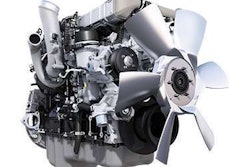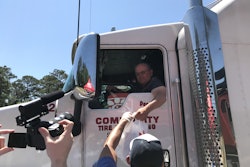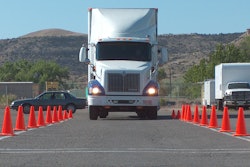Editor’s note: This is the final installment of a two-part series on carriers’ changing mobile technology needs. Part one focused on improving office and driver workflow during the coronavirus pandemic.
In times of crisis such as COVID-19, motor carriers rely more heavily on information technology to stay connected with drivers and assets to help guide their businesses through difficult times.
 Dominoes Pizza franchise owner Steve Casey has been able to scale up operations quickly using the Reveal mobility platform from Verizon Connect.
Dominoes Pizza franchise owner Steve Casey has been able to scale up operations quickly using the Reveal mobility platform from Verizon Connect.Technology may not be able to solve complex problems such as the isolation drivers might feel from not being able to meet with peers and office staff at company terminals due to social distancing procedures, but it can help with tasks that normally were accomplished face-to-face such as training, coaching and performance reviews.
During the crisis, some motor carriers have been re-evaluating their mobile technologies to discover new ways to cut costs and emerge stronger after the pandemic.
During the past two months, sales have boomed for Domino’s Pizza franchise owner Shane Casey who was able to hire 61 new employees across three locations in Southern California during the coronavirus pandemic.
As the company has scaled, it has been using the Verizon Connect Reveal fleet management software platform to improve efficiency, productivity and safety.
The franchise has been using the technology to improve delivery vehicle visibility and tracking of vehicle health.
“Because of the stay-at-home order, customers have limited delivery options, and because of our ability to adapt in times like these, we’ve been able to keep up with the increase in orders and bring on new employees,” Casey said. “I’ve used Reveal to help me track maintenance for my vehicles and keep an eye on employee safety, which is extremely important as we continue to meet this huge increase in demand.”
Keeping drivers connected
Many carriers have been using their investments in video-based safety systems to make a seamless transition to remote driver training during the crisis.
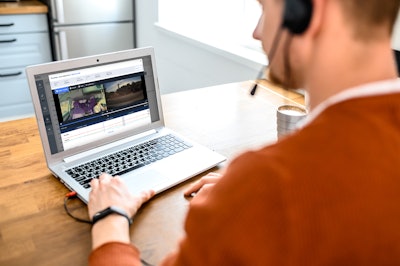 Kansas City, Missouri-based American Central Transport is using remote driver coaching tools from its Lytx DriveCam video-based driver safety system.
Kansas City, Missouri-based American Central Transport is using remote driver coaching tools from its Lytx DriveCam video-based driver safety system.American Central Transport (ACT), a dry-van truckload fleet based in Kansas City, Missouri, is using a video-based safety and telematics system from Lytx to coach drivers remotely on risk-based events.
The Lytx system has the capability for drivers to see event clips while they are coached over the phone by driver training coaches, said Brandon Leininger, director of risk management for ACT, which operates a 310-truck fleet (CCJ Top 250, No. 247).
“Overall, it’s gone as well as you could expect,” Leininger said, adding that in some ways, remote training is making the fleet and drivers more efficient.
Fleet executives, get expert insights on managing your fleet during the pandemic.
Save your spot at our virtual CCJ Symposium, May 27-28, where you'll hear from experts on:
- COVID-19: The Insider Take on Transportation Disruption
- The Essential Guide to Outperforming a Down Market
- Disaster recovery: Lessons Learned in the Bounce Back from Near-Ruin
- On the Front Lines: How to Keep Drivers –and Keep Them Safe – in the Age of COVID-19
- Breaches & Ransom! Why Hackers Think Fleets Are Easy Targets – especially during a pandemic
The company’s new tractors come with collision mitigation technology. When these active safety systems are triggered, Lytx captures video events, and the additional data has added “a new level of risk management and coaching,” Leininger said. “You have to make sure drivers understand what the system is telling them to do and see how they are responding to alerts.”
Besides using technology for remote safety training and risk management, fleets also are using a variety of tools that analyze operational data points to help improve decision making and driver job satisfaction.
Trimble Transportation has developed a number of predictive fleet management tools – TruETA, Trimble Dispatch Advisor and Safety Analytics – that offer recommendations based on real-time analysis of fleet and driver activity.
“Our technology can look at hundreds, thousands or millions of elements in seconds,” said Chris Orban, vice president of data science for Trimble Transportation. “That’s not to say that the technology should be used without human intervention — in fact, exactly the opposite. By using technology to find the exceptions – the areas where the human brain is the only tool we currently have to solve the problem – it allows us to focus on the areas where we can make the biggest impact.”
Driving accountability
During a crisis, especially one with potentially far-reaching impacts on driver safety and business profits such as COVID-19, fleet executives and managers tend to rely more heavily on technology to help with accountability of key performance metrics.
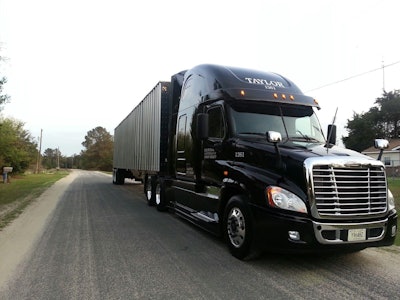 Taylor Express, a Hope Mills, North Carolina-based carbon black hauler, upgraded its mobile technology to the Omnitracs One platform.
Taylor Express, a Hope Mills, North Carolina-based carbon black hauler, upgraded its mobile technology to the Omnitracs One platform.Taylor Express was a Celadon subsidiary before ownership changed following Celadon’s November 2019 bankruptcy. Luminous Management made a stalking-horse bid for Taylor Express during Celadon’s bankruptcy auction.
“We have been through a lot,” said Dave Wiebusch, president of Hope Mills, North Carolina-based Taylor Express, which transports carbon black using bulk hopper trailers. With a new ownership group that includes a New York investment firm, the fleet has been able to invest in its future.
“We are well partnered at this point with Luminous,” Wiebusch said. “They’ve stressed us being world-class. That’s what they want, and that is what we are going to give them.”
Prior to the coronavirus pandemic, management already had decided to upgrade its mobile technology from Omnitracs’ aging MCP200 to the new Omnitracs One platform. Drivers had lost faith in the older technology, which Taylor Express deployed in 2006, and had started using their own devices to communicate with the office.
“That’s not what we want,” Wiebusch said. Regaining drivers’ trust in technology is “probably the most important thing moving forward,” he said.
Wiebusch anticipates the cloud-native Omnitracs One platform – which Taylor Express was set to begin deploying this month – will be integrated with Taylor Express’ McLeod Software system and provide the fleet with dependable communications while improving job satisfaction for drivers.
Taylor Express plans to deploy Omnitracs One on Samsung Galaxy Tab S6 tablets across its 100-truck fleet. With the platform’s data and integration tools, the fleet hopes to build a custom scoreboard for drivers to monitor their performance in fuel efficiency and other areas toward earning bonuses. The tablets also will have a variety of apps for drivers’ personal and business use.
“We’ll give [drivers] more options than they’ve ever had,” Wiebusch said. “I think it is going to boost their satisfaction. It also adds accountability and funnels communication, which is critical. There is satisfaction that comes with being held accountable.”
Leasing information assets
Fleets expect mobile technology to be compatible with existing or future applications that can simplify the workload for office workers and drivers. The expectations are no different for the mobile technology fleets use for leased vehicles.
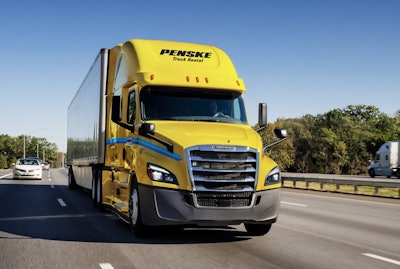 The Connected Fleet platform from Penske Transportation Solutions provides fleets with a variety of self-service maintenance tools.
The Connected Fleet platform from Penske Transportation Solutions provides fleets with a variety of self-service maintenance tools.Penske Transportation Solutions has a Connected Fleet suite of products that uses telematics data from systems factory-installed by truck OEMs and aftermarket telematics service providers (TSPs).
The products include Fleet Insight and a Penske app that the company’s truck leasing customers use to get information and proactive notifications for vehicle health and maintenance needs. Connected Fleet also has integration points for fuel tax automation.
Penske customers can use the self-serve functionality to view updated maintenance information, find the nearest Penske location, log hours of service and more.
“With all the work that is done at home now, our tools have really provided companies the ability to be as efficient as possible,” said Brandie Searle, Penske’s vice president of Connected Fleet product management.
Penske also provides a consulting service for fleets looking to adopt new telematics and mobile fleet management technologies.
“We carry the customer through an extensive process to help evaluate the product, help them purchase it and put upfront costs in the lease rate,” said Samantha Thompson, manager of Fleet Telematics and customer success for Penske, which also helps with installation.
System consolidation
During an economic slowdown, fleets may revisit mobile strategies to eliminate duplicate cellular connections and consolidate functions to give drivers and office personnel a more streamlined user experience. For parked or underutilized assets, it could be an opportune time to upgrade them with new devices equipped with 4G or 5G cellular connectivity.
“If fleets have money to invest in new technology, an economic slowdown is the best time to implement it,” said Chris Wolfe, chief executive officer for PowerFleet, which offers “bumper-to-bumper” fleet mobility products for in-cab and trailer monitoring that use Bluetooth to communicate through a shared single cellular connection.
PowerFleet’s trailer products are used on vans, reefers, chassis and containers. The company also has cargo sensors and cargo image processing that automatically detects load shifts and identifies what percentage of a trailer is loaded with palletized or nonpalletized freight.
As fleets continue to look for ways to scale their technology investments, mobile platforms that allow them to pick and choose “best-of-breed” applications for their businesses have become more important.
Telematics provider Geotab focuses on capturing vehicle data and relies on its partners with expertise in different segments of the transportation industry to help expand its platform with a variety of software and hardware integrations.
Through the Geotab Marketplace, fleets can choose many types of compatible Internet of Things (IoT) systems such as video, tire pressure monitoring and trailer tracking to customize the platform to their specific needs.
All the products in the Geotab Marketplace become integrated with Geotab by capturing data from the vehicle’s network and passing it into the platform through the cellular connection of its GO device.




